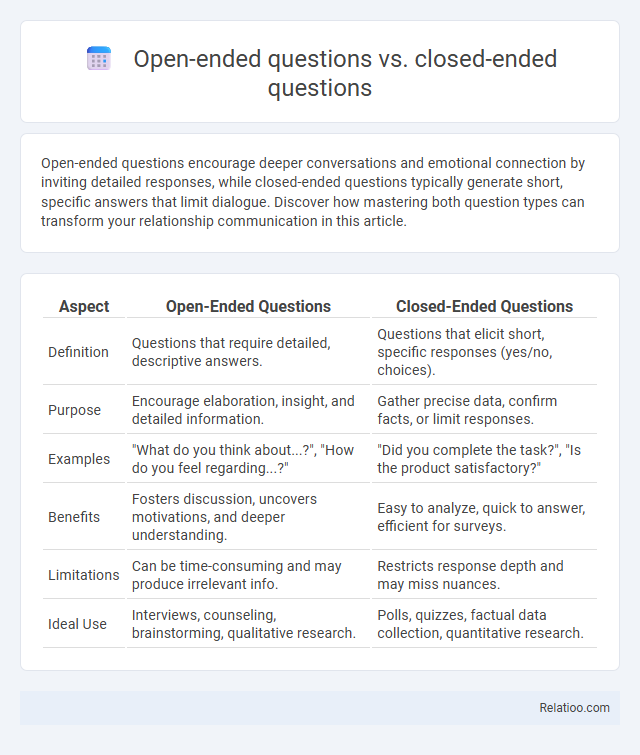Open-ended questions encourage deeper conversations and emotional connection by inviting detailed responses, while closed-ended questions typically generate short, specific answers that limit dialogue. Discover how mastering both question types can transform your relationship communication in this article.
Table of Comparison
| Aspect | Open-Ended Questions | Closed-Ended Questions |
|---|---|---|
| Definition | Questions that require detailed, descriptive answers. | Questions that elicit short, specific responses (yes/no, choices). |
| Purpose | Encourage elaboration, insight, and detailed information. | Gather precise data, confirm facts, or limit responses. |
| Examples | "What do you think about...?", "How do you feel regarding...?" | "Did you complete the task?", "Is the product satisfactory?" |
| Benefits | Fosters discussion, uncovers motivations, and deeper understanding. | Easy to analyze, quick to answer, efficient for surveys. |
| Limitations | Can be time-consuming and may produce irrelevant info. | Restricts response depth and may miss nuances. |
| Ideal Use | Interviews, counseling, brainstorming, qualitative research. | Polls, quizzes, factual data collection, quantitative research. |
Introduction to Open-Ended and Closed-Ended Questions
Open-ended questions encourage detailed responses and foster deeper understanding by allowing you to elaborate freely, while closed-ended questions provide specific, concise answers ideal for gathering quantitative data. Inquiry integrates both types to balance depth and clarity in information gathering, optimizing communication effectiveness. Mastering open-ended and closed-ended questions enhances your ability to extract meaningful insights and engage in productive conversations.
Defining Open-Ended Questions
Open-ended questions invite detailed responses by allowing Your thoughts and opinions without restricting answers to simple yes/no or multiple-choice options, enabling richer dialogue and deeper understanding. Unlike closed-ended questions that limit responses to predetermined options, open-ended inquiries encourage elaboration and insight, crucial for qualitative research and effective communication. Defining open-ended questions involves recognizing their role in fostering exploration, creativity, and comprehensive data collection through prompts that begin with "how," "why," or "what.
Defining Closed-Ended Questions
Closed-ended questions limit responses to specific options like yes/no or multiple choice, making data collection straightforward and quantifiable. These questions streamline surveys and interviews by providing clear, concise answers, reducing ambiguity in your analysis. Understanding the distinct role of closed-ended questions helps enhance the precision of your research and communication strategies.
Key Differences Between Open-Ended and Closed-Ended Questions
Open-ended questions encourage detailed responses, allowing for deeper insight and exploration of thoughts, while closed-ended questions limit answers to specific options like yes/no or multiple-choice, facilitating quick data collection and analysis. Inquiry encompasses both question types but emphasizes the process of seeking information, understanding, and knowledge through structured or exploratory questioning. Key differences lie in response depth, flexibility, and intended use, with open-ended questions promoting elaboration and closed-ended questions enabling straightforward measurement.
Advantages of Open-Ended Questions
Open-ended questions foster deeper engagement by encouraging Your elaboration, critical thinking, and creativity, leading to richer, more detailed responses than closed-ended questions. These questions uncover insights, emotions, and motivations that simple yes/no or multiple-choice formats often miss. This advantage makes open-ended inquiries essential for qualitative research, effective communication, and problem-solving scenarios.
Advantages of Closed-Ended Questions
Closed-ended questions provide clear, concise answers that are easy to quantify, making data analysis straightforward and efficient. They reduce ambiguity and save time during surveys or interviews by limiting responses to specific options. Your ability to quickly gather structured information enhances decision-making processes and improves overall communication clarity.
Disadvantages of Open-Ended Questions
Open-ended questions often result in varied, lengthy responses that can be difficult to analyze quantitatively, leading to challenges in data consistency and comparison. They may also consume more time during surveys or interviews, reducing overall efficiency in information gathering. Furthermore, respondents might provide irrelevant or off-topic answers, complicating the extraction of precise insights.
Disadvantages of Closed-Ended Questions
Closed-ended questions limit responses to predefined options, restricting depth and nuance in answers and potentially overlooking valuable insights. They can lead to biased data if respondents choose options that don't fully represent their experience or opinions. This lack of flexibility reduces opportunities for exploration and critical thinking compared to open-ended questions or inquiry-based approaches.
When to Use Open-Ended vs Closed-Ended Questions
Open-ended questions are most effective for exploring thoughts, feelings, and detailed explanations, encouraging respondents to provide rich, descriptive answers. Closed-ended questions work best when quick, specific information or quantitative data is needed, allowing for straightforward analysis and comparison. Use open-ended questions during qualitative research, interviews, and brainstorming sessions, while closed-ended questions are ideal for surveys, polls, and decision-making processes where clear-cut answers simplify results.
Best Practices for Crafting Effective Questions
Open-ended questions encourage detailed responses and foster critical thinking, while closed-ended questions provide specific, concise answers useful for gathering quantifiable data. Craft questions with clarity, avoid ambiguity, and tailor them to the desired information type, ensuring alignment with research objectives or conversation goals. Effective inquiry combines both question types strategically to balance depth of insight and ease of analysis.

Infographic: Open-ended questions vs closed-ended questions
 relatioo.com
relatioo.com